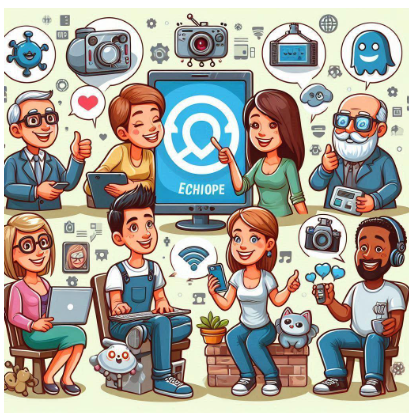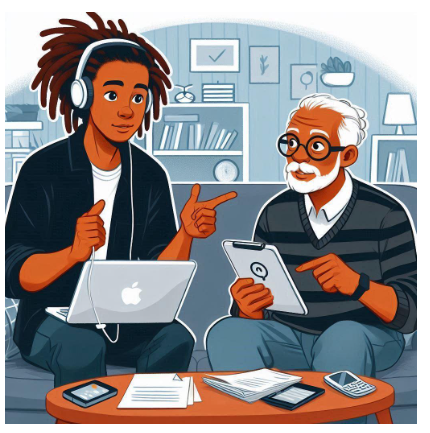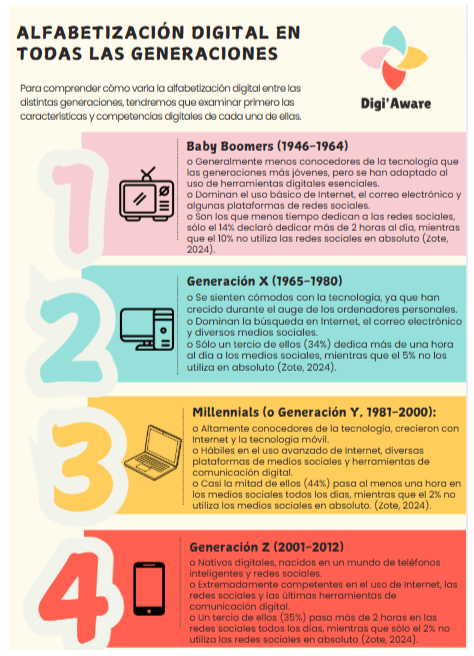
Módulo 5: Entendiendo la brecha generacional del nuevo pacto tecnológico

Finalidad del módulo
El objetivo de este módulo es proporcionar a los alumnos una comprensión de cómo la alfabetización digital y las actitudes hacia la tecnología varían a través de las generaciones, desde los Baby Boomers hasta la Generación Z. El conocimiento de los contextos socioculturales y las influencias históricas que dan forma a estas diferencias ayudará a los alumnos a desarrollar las habilidades necesarias para reconocer y apreciar las diferencias generacionales, fomentar la empatía y la toma de perspectiva, y comunicarse de manera efectiva a través de las divisiones generacionales. Este módulo tiene como objetivo permitir a los alumnos cerrar las brechas generacionales y, por lo tanto, guiar a las personas de diferentes edades para que trabajen mejor juntas en línea y cara a cara.
Resultados de aprendizaje
Después de completar este módulo, los alumnos obtendrán el conocimiento y las habilidades necesarias para reconocer y apreciar las diferencias generacionales, fomentar la empatía y la toma de perspectiva, y comunicarse de manera efectiva a través de las divisiones generacionales. Los resultados de aprendizaje de este módulo son los siguientes:
Conocimientos
- a. Alfabetización digital intergeneracional:
Comprensión de cómo varía la alfabetización digital a través de diferentes generaciones, incluidos los Baby Boomers, la Generación X, los Millennials y la Generación Z.
Familiaridad con las habilidades y competencias digitales comúnmente asociadas con cada generación, como el uso de Internet, el dominio de las redes sociales y las preferencias de comunicación digital.
- b. Actitudes hacia la tecnología:
Conocimiento de las diferencias generacionales en actitudes, creencias y comportamientos relacionados con la adopción y el uso de la tecnología.
Comprensión de los factores que influyen en las actitudes hacia la tecnología, como el origen socioeconómico, las normas culturales y las experiencias de vida.
- Contexto sociocultural:
Conciencia del contexto sociocultural que da forma a las perspectivas generacionales sobre la tecnología, incluidos los acontecimientos históricos, los avances tecnológicos y los cambios sociales.
Comprensión de cómo las normas y los valores sociales influyen en las interacciones intergeneracionales y los patrones de comunicación en entornos digitales.
Habilidades
- a. Reconocimiento de las diferencias:
Capacidad para reconocer y apreciar las diferencias en los niveles de alfabetización digital y las actitudes hacia la tecnología entre las diferentes generaciones.
Habilidad para observar e identificar las preferencias, comportamientos y desafíos generacionales relacionados con el uso de la tecnología.
- b. Empatía y toma de perspectiva:
Capacidad de empatía y toma de perspectiva para comprender las perspectivas y experiencias de individuos de diferentes generaciones.
Habilidad para ponerse en el lugar de los demás y ver el mundo a través de sus ojos, especialmente en lo que respecta a los asuntos relacionados con la tecnología.
- c. Comunicación intergeneracional:
Competence in adapting communication styles and strategies to effectively engage and connect with individuals from diverse generational backgrounds.
Competencia en la adaptación de estilos y estrategias de comunicación para interactuar y conectarse de manera efectiva con personas de diversos orígenes generacionales. Habilidad para fomentar el diálogo abierto, la escucha activa y el respeto mutuo en las interacciones intergeneracionales, tanto en línea como fuera de línea.
- d. Estrategias de puente:
Capacidad para desarrollar e implementar estrategias para reducir la brecha generacional y fomentar el entendimiento mutuo en contextos digitales.
Habilidad para facilitar experiencias de aprendizaje intergeneracional, programas de tutoría o proyectos colaborativos para promover el intercambio de conocimientos y el desarrollo de habilidades entre generaciones.
Lista de temas
En este tema, los alumnos pueden comparar la alfabetización digital y las habilidades de diferentes grupos generacionales: Baby Boomers, Generación X, Millennials y Generación Z. Explorarán las características únicas, las adaptaciones tecnológicas y el uso de las redes sociales para comprender mejor cómo difiere la competencia digital entre los grupos de edad.
El tema explora cómo la tecnología impacta en diferentes grupos de edad y destaca la importancia de aprender nuevas habilidades digitales para navegar por el mundo en línea. Examina las posibles razones detrás de las habilidades digitales, las preferencias de comunicación y los patrones de uso de la tecnología de los Baby Boomers, la Generación X, los Millennials y la Generación Z para comprender cómo cada generación interactúa con la tecnología.
El propósito de este módulo es examinar cómo las diferentes generaciones se comunican entre sí, teniendo en cuenta los eventos históricos, los cambios sociales y el progreso tecnológico. Se centrará en las distintas características y experiencias de los Baby Boomers, la Generación X, los Millennials y la Generación Z. Este tema tiene como objetivo fomentar la comprensión y la empatía entre generaciones, al tiempo que identifica estrategias efectivas para cerrar las brechas generacionales y fomentar la colaboración en los lugares de trabajo, las comunidades y las familias.
Objetivo, conceptos clave, habilidades a desarrollar
Al final de este módulo, obtendrá una comprensión clara de cómo varía la alfabetización digital entre las diferentes generaciones. Reconocerás las diferencias generacionales en actitudes, creencias y comportamientos relacionados con la adopción y el uso de la tecnología, así como los factores que impulsan estas diferencias. Con este conocimiento, estará mejor equipado para ajustar sus estilos y estrategias de comunicación para interactuar de manera efectiva con personas de diferentes generaciones. Esto promoverá el diálogo abierto, la escucha activa y el respeto mutuo en las interacciones tanto en línea como fuera de línea. Además, mejorará su empatía y sus habilidades de toma de perspectiva a través de actividades atractivas.
Guía de aprendizaje
A lo largo de este módulo, explorará las diferencias generacionales y su impacto en los enfoques de la vida, los estilos de comunicación y el uso de la tecnología. También descubrirá si hay diferencias en las plataformas en línea que prefiere cada generación y la cantidad de tiempo que pasan en línea. También obtendrás información sobre los factores socioculturales que dan forma a estos comportamientos, lo que te ayudará a ver diferentes perspectivas con mayor empatía. Una historia de caso inspiradora, seguida de hechos reveladores y actividades atractivas, lo guiará hacia una comprensión más profunda de las diversas personas que lo rodean. Esta experiencia puede incluso ayudar a reducir las brechas intergeneracionales tanto en el mundo real como en el digital. Como educador, tendrá la capacidad de transmitir este conocimiento a sus alumnos, ampliando aún más la influencia.
Relato motivador
Reducción de la brecha digital
En la Irlanda rural, dos vecinos siempre habían sido amables el uno con el otro, pero nunca sintieron que tuvieran mucho en común. El Sr. O'Brien es un bibliotecario jubilado, mientras que Lucy es una influencer de las redes sociales de 25 años que trabaja con algunas marcas emergentes muy impresionantes. Los 2 vecinos siempre han tenido breves charlas amistosas, pero no sabían mucho el uno del otro. Un día, el señor O'Brien le preguntó a Lucy si podía echar un vistazo a un correo electrónico que había recibido hacía un par de días. Lucy estuvo feliz de ayudar, y acordaron que ella llamara más tarde esa noche.
Cuando Lucy fue a la casa del Sr. O'Brien, se sorprendió al ver que estaba usando una computadora de escritorio de aspecto muy antiguo, era bastante lenta, pero lograron localizar el correo electrónico relevante entre todo el resto del spam en el buzón. El correo electrónico fue enviado por su nieto, Jonny, con una invitación para que el Sr. O'Brien se uniera a una llamada de Zoom con una pequeña nota de Jonny diciendo que ahora tiene una tableta y que le encantaría usar Zoom en lugar del teléfono para sus llamadas semanales.
Desafortunadamente, la computadora que tenía el Sr. O'Brien no podía instalar Zoom, sin embargo, Lucy tenía una tableta sin usar que había actualizado recientemente. Entonces, ella lo configuró para el Sr. O'Brien y también lo ayudó a ordenar su configuración de privacidad para que no recibiera tantos correos electrónicos no deseados.
Mientras tanto, el señor O'Brien compartía historias de su juventud, los días en que las cartas viajaban en carruajes tirados por caballos y los telegramas traían noticias de tierras lejanas. Lucy escuchaba, cautivada por la riqueza de la historia. Le hizo darse cuenta de que la tecnología no se trataba solo de progreso, sino también de preservar los recuerdos y transmitirlos. Algunas de estas historias le dieron la inspiración más valiosa para crear contenido nuevo e interesante para sus publicaciones en TikTok. En una de las historias, el Sr. O'Brien describió como solía esperar una carta de su futura esposa, para que pudieran reunirse en un momento y lugar específicos. Todo parecía moverse a un ritmo mucho más lento en ese entonces. Esta historia inspiró a Lucy a escribir un post sobre la simplificación de las tareas cotidianas y la importancia de no estar disponible las 24 horas del día, los 7 días de la semana por el bien de la salud mental.
Una amistad inesperada se formó cuando una generación necesitó ayuda, inspirando una conexión que cerró la brecha generacional. El Sr. O'Brien aprendió a aceptar lentamente los beneficios de la tecnología, mientras que Lucy aprendió el valor de la conexión humana y los beneficios de la comunicación fuera del mundo en línea.

Tema 1 - Alfabetización digital intergeneracional
Para entender cómo varía la alfabetización digital entre las diferentes generaciones, primero tendremos que analizar las características y competencias digitales de cada una de estas generaciones.
- Las personas de esta generación a menudo valoran la visibilidad en el lugar de trabajo, se enorgullecen de su trabajo y suelen ser competitivas. Muchos baby boomers quieren seguir trabajando, aunque tengan la oportunidad de jubilarse. El arduo trabajo y el enfoque de la generación del baby boom dieron como resultado que muchos boomers valoraran la toma de decisiones objetiva y racional. Los Baby Boomers son aprendices de por vida. Los dispositivos móviles y la información compartida a través de Internet han hecho de la tecnología una plataforma importante para el aprendizaje. Sin embargo, es un error popular pensar que los Baby Boomers son ajenos a la tecnología (Huyler y Ciocca, 2016). Los Baby Boomers son:
- En general, son menos expertos en tecnología que las generaciones más jóvenes, pero se han adaptado al uso de herramientas digitales esenciales.
- Competentes en el uso básico de Internet, correo electrónico y algunas plataformas de redes sociales.
- Pasan la menor cantidad de tiempo en las redes sociales, solo el 14% informó que pasa más de 2 horas al día, mientras que el 10% no usa las redes sociales en absoluto (Zote, 2024).
- Estos individuos han visto el surgimiento de las tecnologías digitales y el impacto de las tecnologías cambiantes en la vida social. Pueden ser escépticos sobre el uso de las tecnologías digitales. Por esta razón, son menos dependientes de muchas tecnologías digitales, incluidos los teléfonos inteligentes (Çoklar y Tatli, 2021). La Generación X:
- Se encuentran cómodos con la tecnología, habiendo crecido durante el auge de las computadoras personales.
- Son competentes en investigación de Internet, correo electrónico y una variedad de redes sociales.
- Solo un tercio de ellos (34%) pasa más de una hora al día en las redes sociales, mientras que el 5% no las usa en absoluto. (Zote, 2024).
- Son los hijos del período de transición. La tecnología digital es parte de su vida diaria y se sienten cómodos usando pantallas en sus vidas. Sin embargo, no nacieron en el mundo digital, migraron del mundo analógico al mundo digital. (Çoklar y Tatli, 2021). Los millennials son:
- Muy conocedores de la tecnología, creció con Internet y la tecnología móvil.
- Expertos en el uso avanzado de Internet, diversas plataformas de redes sociales y herramientas de comunicación digital.
- Casi la mitad de ellos (44%) pasa al menos una hora en las redes sociales todos los días, mientras que el 2% no usa las redes sociales en absoluto. (Zote, 2024).
- Son individuos que no conocen un mundo sin internet y tecnologías digitales y nacieron directamente en las tecnologías digitales. Es por eso por lo que la digitalición es parte de su ADN, y por qué se les puede acuñar como nativos digitales (Prensky, 2001)Prefieren la gratificación instantánea y tienden a querer todo de inmediato. Con acceso constante a Internet rápido, comunicación instantánea y servicios a la carta (como plataformas de streaming y redes sociales), esta generación se ha acostumbrado a resultados rápidos y acceso inmediato a información, entretenimiento y productos. La expectativa de que las cosas sucedan rápidamente es un indicador de cómo la tecnología ha moldeado sus comportamientos y preferencias. Si bien son expertos en la multitarea, su capacidad de atención suele ser corta (Çoklar y Tatli, 2021). La Generación Z son:
- Nativos digitales, nacidos en un mundo de teléfonos inteligentes y redes sociales.
- Extremadamente competentes en el uso de Internet, las redes sociales y las últimas herramientas de comunicación digital.
- Un tercio de ellos (35%) pasa más de 2 horas en las redes sociales todos los días, mientras que solo el 2% no usa las redes sociales en absoluto. (Zote, 2024).
Obtenga más datos sobre las diferencias entre generaciones viendo este video de YouTube..
Actividad de narración de cuentos: explorando la alfabetización digital a través de las generaciones
Duración: 45 minutos
Los alumnos utilizarán la narración de historias para comparar y comprender el concepto de alfabetización digital y las habilidades de varios grupos generacionales: Baby Boomers, Generación X, Millennials y Generación Z.
Materiales necesarios:
- Rotafolio o pizarra blanca y rotuladores
- Post-its y bolígrafos
- Temporizador
- Desglose de la actividad
- Introducción a la Actividad (5 minutos)
Presente el tema y asegúrese de que los participantes hayan leído el contenido del módulo sobre el tema "Alfabetización digital a través de las generaciones".
Rompehielos: Pida a los participantes que compartan una pieza de tecnología que usaron ampliamente cuando eran adolescentes o adultos jóvenes (por ejemplo, máquina de escribir, VHS, computadora, teléfono inteligente) y una plataforma de redes sociales que usan a diario ahora.
- Preparación (10 minutos)
Divida a los participantes en cuatro grupos y asigne a cada grupo una de las generaciones: Baby Boomers, Generación X, Millennials y Generación Z.
Explique que cada grupo creará una presentación de narración de cuentos desde la perspectiva de su generación asignada, centrándose en:
- Antecedentes generales de la generación.
- ¿Cómo afecta el trasfondo a sus conocimientos tecnológicos?
- Su alfabetización digital actual y el uso de las redes sociales.
- ¿Qué plataforma de redes sociales es probable que utilicen?
- Desarrollo de la historia (15 minutos)
Los grupos deben comenzar dedicando unos minutos a hacer una lluvia de ideas y discutir las experiencias de su generación asignada con la tecnología. Después, organizarán sus historias identificando los puntos clave que quieren destacar y asignando roles si deciden realizar partes de la historia. La historia se puede presentar en varios formatos, como una obra de teatro corta, un cómic o incluso un video breve (no más de 2-3 minutos) si se puede mostrar al resto del grupo durante la etapa de presentación.
- Presentaciones de narración de cuentos (10 minutos)
Cada grupo tiene unos minutos para presentar su historia al resto de los grupos. Guíe a los participantes a ser amables con su narración para evitar ofender a otros participantes que puedan estar dentro de la generación descrita.
- Discusión y reflexión (10 minutos)
Después de todas las presentaciones, facilite una discusión grupal con las siguientes preguntas:
- ¿Qué similitudes y diferencias notaste entre las generaciones?
- ¿Qué podemos aprender de cada generación y cómo se adaptaron a los cambios tecnológicos?
Invite a los participantes a reflexionar sobre su propia alfabetización digital y cómo se ha desarrollado a lo largo del tiempo. ¿Qué desafíos han enfrentado y cómo los superaron?
- Conclusión (5 minutos)
Resuma los puntos clave discutidos durante la actividad y pregunte a los participantes si les gustaría agregar algo o compartir más experiencias sobre el tema.

Tema 2 – Actitudes hacia la tecnología
La tecnología está cambiando la forma en que vivimos, haciendo que todo sea más rápido y esté más conectado. Es importante aprender habilidades digitales para navegar en este nuevo mundo digital. En este módulo, echaremos un vistazo a las habilidades digitales de diferentes grupos de edad y examinaremos cómo utilizan la tecnología.
Enfoque de la vida y su efecto en las actitudes hacia la tecnología:
- Los valores de los Baby Boomers provienen del colectivismo, el idealismo y los ideales revolucionarios. Históricamente han reportado tendencias hacia las fuentes de los medios de comunicación nativos, como los periódicos, la radio y la televisión. Desde entonces, los baby boomers se han autoproclamado como los "inmigrantes digitales" de la sociedad.
- La Generación X sigue un estilo de vida de "trabajar duro, jugar duro". Son independientes, criados con una supervisión mínima de un adulto, y pueden ser ingeniosos y describirse tecnológicamente como "híbridos". Se enfocan en mantenerse en contacto con pequeños grupos de personas con conexiones significativas, compartir opiniones con colegas de ideas afines y recopilar información. (Rosa, 2023)
- Los millennials generalmente priorizarán el estilo de vida y la satisfacción profesional sobre el salario. Esta generación también es conocida por usar las redes sociales para conectarse con amigos y familiares, investigar eventos sociales y actualizaciones globales, como entretenimiento y para compartir contenido.
- La Generación Z, también conocida como post-Millennials, son verdaderos nativos digitales. Son expertos en tecnología, aprenden rápido y esperan una comunicación instantánea a través de varios canales digitales. La Generación Z ve las plataformas sociales como una extensión natural de su vida social. (Harris, 2023)
Estilos de comunicación:
- Los Baby Boomers priorizan las conexiones personales y la comunicación formal. Aprecian las llamadas telefónicas, las reuniones y los memorandos. Respetar su experiencia y conocimiento fomenta la comunicación efectiva.
- La Generación X prefiere una comunicación directa y concisa. Les gustan los correos electrónicos y las interacciones cara a cara, pero también se adaptan bien a los canales digitales. A menudo buscan un equilibrio entre el trabajo y la vida personal y valoran un enfoque orientado a los resultados.
- Los millennials valoran la autenticidad y la comunicación abierta. Prefieren plataformas interactivas como aplicaciones de mensajería, correo electrónico y redes sociales.
- La Generación Z adopta la comunicación digital como una segunda naturaleza. Prefieren la mensajería instantánea, las videoconferencias y las herramientas de colaboración. Aprecian los comentarios auténticos y en tiempo real y buscan espacios de trabajo diversos e inclusivos (Harris, 2023)

Los motivos comunes detrás de la manipulación de los medios de comunicación incluyen:
Uso de la tecnología:
Los Baby Boomers utilizan Internet principalmente para recopilar información y mantenerse actualizados sobre eventos globales, noticias de salud y actualizaciones financieras. A menudo se les describe como consumidores de "contenido de calidad", que pasan más tiempo en línea y ven constantemente los medios en comparación con cualquier otra generación. Facebook, LinkedIn y Pinterest son particularmente populares entre este grupo, lo que refuerza su reputación como espectadores dedicados de contenido de alta calidad.
La Generación X utiliza las redes sociales tanto para fines personales como profesionales. Prefieren los siguientes canales: Facebook, LinkedIn y Twitter/X, así como YouTube e Instagram.
Los millennials utilizan activamente Instagram, Snapchat, Twitter, así como Facebook y YouTube.
El 45% de la Generación Z afirma estar en línea "casi constantemente", esta generación podría etiquetarse como demasiado apegada a las plataformas virtuales. Comparten su marca personal a través de plataformas como TikTok, Instagram, Snapchat y YouTube (Rosa, 2023; Zote, 2024).
Comprender los perfiles digitales de las diferentes generaciones nos permite crear programas educativos inclusivos y diseñar tecnología que sea fácil de usar para todos. Adoptar la alfabetización digital en todos los grupos de edad mejora la calidad de vida en nuestro mundo cada vez más conectado.
Actividad de mapeo de empatía: Derretir la brecha digital mediante el cambio de perspectiva
Duración: 45 minutos
Los alumnos explorarán el "mapeo de la empatía" para fomentar la sensibilidad y la comprensión entre los diferentes grupos generacionales con respecto a su uso y actitudes hacia la tecnología. Tendrán la oportunidad de practicar la toma de perspectiva al considerar cómo varios grupos de edad interactúan con el mundo digital.
Materiales necesarios:
- Rotafolio y rotuladores
- Post-its y bolígrafos
- Introducción a la actividad (5 minutos)
Presente el tema y asegúrese de que los participantes hayan leído el contenido del módulo para el tema "Actitudes hacia la tecnología".
- Discusión en grupo (15 minutos)
Divida a los participantes en grupos pequeños. Cada grupo se centrará en una generación.
Pida a cada grupo que analice y anote:
- ¿Cuáles creen que son los principales desafíos tecnológicos para la generación asignada y por qué?
- Cómo su generación asignada se beneficia de la tecnología.
- ¿Cómo aumentar la alfabetización digital de la generación asignada?
Después de los análisis, pida a cada grupo que comparta sus ideas con el grupo más grande.

- Ejercicio de mapeo de empatía (15 minutos)
Presente el ejercicio de mapeo de empatía y explique cómo implica comprender la experiencia, los sentimientos y la perspectiva de otra persona.
- (Breve video de YouTube. sobre el Mapeo de la Empatía para guiar al facilitador en la comprensión del Mapeo de la Empatía).
Entregue a cada grupo una hoja de papel grande dividida en cuatro: "Dice", "Piensa", "Hace" y "Siente".
Pida a los grupos que completen el mapa de empatía para un miembro típico de su generación asignada en el contexto del uso de la tecnología. Indíqueles preguntas como:
- ¿Qué dice esta persona sobre la tecnología?
- ¿Qué piensan de sus experiencias digitales?
- ¿Qué hacen cuando interactúan con la tecnología?
- ¿Qué opinan del mundo digital?
- Paseo de la galería (5 minutos)
Una vez que los participantes hayan completado sus mapas de empatía, haga que los grupos los publiquen alrededor de la sala.
Permita que los participantes caminen y revisen los mapas de empatía creados por otros grupos. Anímelos a escribir comentarios o preguntas en notas adhesivas y colocarlas en los mapas.
- Reflexión y discusión (10 minutos)
Vuelva a reunir a los participantes para una discusión grupal.
- Facilite una discusión sobre temas comunes, descubrimientos sorprendentes y qué efecto podrían tener estas percepciones en sus interacciones futuras con diferentes generaciones.
- Pida a cada grupo que comparta una idea clave que hayan obtenido del mapa de empatía de otra generación.
- Destacar la importancia de la empatía y la toma de perspectiva en la creación de espacios digitales inclusivos.

Tema 3 – Contexto sociocultural y comunicación intergeneracional
En nuestro mundo interconectado, comprender la comunicación intergeneracional es crucial. Diferentes grupos de edad han crecido con diferentes tecnologías, normas sociales e influencias culturales que dan forma a sus perspectivas sobre diversos temas. Echemos un vistazo a la dinámica de la comunicación intergeneracional, teniendo en cuenta el contexto histórico, las influencias sociales y los métodos para cerrar las brechas generacionales.
La adopción de la tecnología por parte de cada generación está determinada por acontecimientos históricos, cambios culturales y experiencias generacionales. Estos son algunos puntos clave:
La tecnología más común utilizada para la información fue la radio, así como la televisión predominantemente en blanco y negro. Esta es la generación que escuchó, o vio, el alunizaje desde sus salas de estar. El estilo de aprendizaje de esta generación tiende a ser más auditivo: quieren que las personas les hablen, en persona o por teléfono. Se sabe que disfrutan de una buena discusión. También experimentaron el auge de las computadoras personales (PC), Internet y los teléfonos móviles. A pesar de que se han adaptado bien a las tecnologías digitales, es posible que sigan prefiriendo los métodos de comunicación tradicionales.
Con el regreso de las mujeres a la fuerza laboral y el aumento de las tasas de divorcio, la Generación X a menudo se quedaba sola en casa con sus televisores en color. Como resultado, muchos se volvieron independientes, autosuficientes y librepensadores. La generación que inventó el correo electrónico creció durante una época de desilusión. Con acontecimientos históricos como la guerra de Vietnam, su confianza en la autoridad se resintió. Como resultado, esta generación típicamente escéptica mostró menos respeto por el servicio, el título o el rango y, en cambio, valoró la competencia y la individualidad. Su estilo de aprendizaje preferido tiende a ser visual: quieren ver lo que está sucediendo y cómo funciona. Fueron testigos de la transición de lo analógico a lo digital. Se sienten cómodos con la comunicación tanto en línea como fuera de línea.
Esta generación creció durante la digital revolución digital y la llegada de los smartphones. Han vivido la vida con y sin tecnología digital. Los millennials crecieron en familias diversas y mixtas y tienden a tener relaciones familiares cercanas. Los teléfonos inteligentes permitieron conexiones en todo el mundo y ayudaron a crear y mantener relaciones. Generalmente aplastados por las deudas y golpeados por la injusticia en el hogar y el trabajo, muchos de los miembros de esta generación experta en tecnología se volvieron más creativos, empáticos y conscientes de los problemas globales que las generaciones anteriores. El chat (mensajería instantánea) y los mensajes de texto permitieron a esta generación dar y recibir información más rápidamente que otras. Como resultado, se sabe que prefieren el aprendizaje kinestésico (aprenden haciendo).
La Generación Z es una población cada vez más diversa y se preocupa profundamente por cuestiones como la igualdad, la diversidad y el cambio climático. A menudo son activistas por naturaleza y quieren ver al gobierno involucrado en soluciones a problemas grandes y arraigados. Moldeados por la pandemia mundial, tienden a aprender de las redes sociales (Twitter/X, Instagram, Snapchat y TikTok) y a ser impulsados por ellas (Facebook se considera ya "anticuado") y valoran las ráfagas de pensamiento cortas y rápidas que son relevantes para la conversación actual. Al haber crecido con la tecnología, se sabe que son "nativos digitales” (Denison, 2024).
Con base en esta información, está claro que hay ciertas características para las diferentes generaciones, y podemos ver cómo los eventos históricos que tuvieron lugar durante sus vidas han influido en esto. Echemos un vistazo a cómo podemos usar esta información para crear comunidades más comprensivas.
Para fomentar la comprensión y la colaboración es importante:
- Fomentar diálogos abiertos que promuevan la empatía, así como
- Compartir perspectivas y experiencias sin suposiciones
- Crear un entorno equilibrado ya sea en entornos de trabajo o de aprendizaje
- Crear equipos intergeneracionales para iniciativas conjuntas
- Apoyar diversas habilidades y puntos de vista.
- Fomentar la mentoría y la mentoría inversa
- Adaptar los estilos de comunicación para interactuar de manera efectiva con todos los grupos de edad
- Sé flexible, paciente y respetuoso (O'Neill, 2024).
La comunicación intergeneracional enriquece nuestros lugares de trabajo, comunidades y familias. Al aceptar las diferencias y fomentar la empatía, podemos construir puentes que trasciendan generaciones, creando un mundo más conectado y armonioso.
Mira este análisis en profundidad del impacto que diferentes aspectos, incluida la tecnología, tienen en toda una generación en el siguiente video de YouTube.
Estrategias para cerrar brechas generacionales
Duración: 30 minutos
Los alumnos obtendrán una comprensión y colaborarán entre diferentes generaciones explorando sus características únicas, estilos de aprendizaje y contextos históricos. Esto puede guiarlos a desarrollar estrategias que cierren las brechas generacionales.
Materiales necesarios:
Rotafolio o pizarra blanca y rotuladores
Post-its y bolígrafos
Temporizador
- Introducción a la Actividad (5 minutos)
Presente el tema de la reducción de las brechas generacionales a los participantes y asegúrese de que los participantes hayan leído el contenido del módulo sobre el tema "Contexto sociocultural y comunicación intergeneracional".
Pida a los participantes que mencionen una tecnología o un fenómeno cultural de su juventud que los haya impactado significativamente.
- Trabajo en grupo: Estrategias para cerrar las brechas generacionales (15 minutos)
Pida a los participantes que formen grupos pequeños y, si es posible, asegúrese de que cada grupo tenga miembros de diferentes generaciones.
A cada grupo se le asignará una de las siguientes estrategias:
- Fomentar diálogos abiertos que promuevan la empatía
- Crear un entorno equilibrado ya sea en entornos de trabajo o de aprendizaje
- Crear equipos intergeneracionales para iniciativas conjuntas
- Apoyar diversas habilidades y puntos de vista
- Fomentar la mentoría y la mentoría inversa
Su tarea es hacer una lluvia de ideas sobre formas prácticas de implementarlo en su lugar de trabajo, comunidad o familia.
- Presentación de las estrategias y reflexión (10 minutos)
- Pida a cada grupo que comparta sus ideas sobre cómo implementar la estrategia elegida.
- Resumir los puntos clave discutidos durante la actividad.
- Resalte la importancia de la empatía, la comprensión y la colaboración entre generaciones.
- Anime a los participantes a continuar estas conversaciones más allá de esta actividad.

Resumen del módulo
La alfabetización digital varía significativamente entre las diferentes generaciones, influenciada por el entorno tecnológico en el que crecieron. Los Baby Boomers, aunque menos conocedores de la tecnología, se han adaptado a herramientas digitales esenciales y siguen siendo aprendices activos. La Generación X, que ha experimentado los albores de la informática personal, se siente cómoda con la tecnología, pero menos dependiente de ella en comparación con las generaciones más jóvenes. Los millennials, que crecieron durante la transición a un mundo digital, son muy hábiles en el uso de una amplia gama de herramientas digitales y plataformas de redes sociales. La Generación Z, como nativos digitales, son los más competentes en tecnologías digitales, integrándolas en todos los aspectos de sus vidas. Comprender estas diferencias generacionales en la alfabetización digital es crucial para adaptar la educación, la comunicación y el diseño tecnológico para satisfacer las necesidades y fortalezas únicas de cada grupo.
El impacto de la tecnología en nuestras vidas pone de manifiesto la importancia de desarrollar habilidades digitales para navegar por el panorama digital de forma eficaz. Este módulo destaca cómo las diferentes generaciones abordan y utilizan la tecnología, ilustrando sus competencias digitales únicas y preferencias de comunicación.
Los Baby Boomers, como "inmigrantes digitales", priorizan el contenido de calidad y las conexiones personales, principalmente utilizando la tecnología para obtener información y actualizaciones globales. La Generación X, descrita como "híbrida", valora la comunicación concisa y utiliza la tecnología tanto para fines personales como profesionales. Los millennials priorizan la satisfacción con el estilo de vida y la comunicación abierta, utilizando las redes sociales para la conexión y el entretenimiento. La Generación Z, los verdaderos "digital natives”, integran la comunicación digital en sus vidas, utilizando una amplia gama de plataformas para obtener retroalimentación instantánea y marca personal.
Comprender la comunicación intergeneracional es esencial en nuestro mundo en constante evolución e interconectado. Cada generación, moldeada por ciertos eventos históricos e influencias sociales, tiene perspectivas y preferencias de comunicación únicas. Los Baby Boomers valoran la comunicación auditiva y tradicional, la Generación X se nutre del aprendizaje visual y la independencia, los Millennials son excelentes para aprender haciendo y la conectividad digital, y la Generación Z, como nativos digitales, está impulsada por las redes sociales y el activismo.
Para cerrar las brechas generacionales, debemos fomentar diálogos abiertos, compartir experiencias sin suposiciones y crear entornos equilibrados tanto en el trabajo como en el aprendizaje. La formación de equipos intergeneracionales y la promoción de la tutoría pueden mejorar diversas habilidades y puntos de vista. Adaptar los estilos de comunicación para involucrar a todos los grupos de edad, siendo flexibles, pacientes y respetuosos, es clave para construir puentes entre generaciones y crear un mundo más conectado y pacífico.
Module 5: Quiz
Glosario de términos
Una situación en la que las personas mayores y jóvenes no se entienden entre sí debido a sus diferentes experiencias, opiniones, hábitos y comportamientos. Fuente: Diccionario Cambridge.
El problema de que algunos miembros de la sociedad no tienen la oportunidad o el conocimiento para usar las computadoras e internet que otros tienen. Fuente: Diccionario Cambridge..
Una persona que está muy familiarizada con la tecnología digital, los ordenadores, etc. porque ha crecido con ellos. Fuente: Diccionario Cambridge.
Una persona que comenzó a usar la tecnología digital, computadoras, Internet, etc. durante su vida adulta, pero no creció usándolas. Fuente: Diccionario Cambridge.
Se refiere al avance de la tecnología de los dispositivos electrónicos y mecánicos analógicos a la tecnología digital disponible en la actualidad. Source: Beal, 2024
Bibliografía y referencias


Financiado por la Unión Europea. Sin embargo, las opiniones y puntos de vista expresados son exclusivamente los de los autores y no reflejan necesariamente los de la Unión Europea ni los de la Agencia Ejecutiva en el ámbito Educativo, Audiovisual y Cultural (EACEA). Ni la Unión Europea ni la EACEA se hacen responsables de ellos. Número de proyecto: 2023-1-NO01-KA220-ADU-

